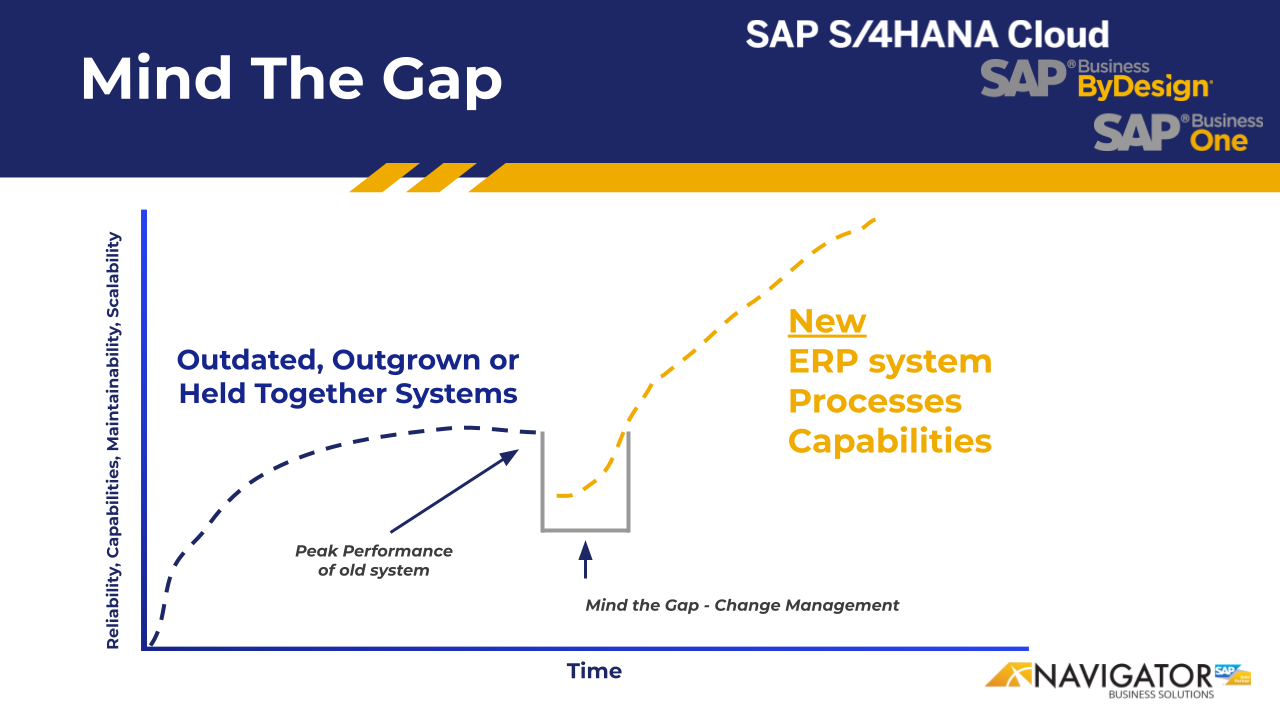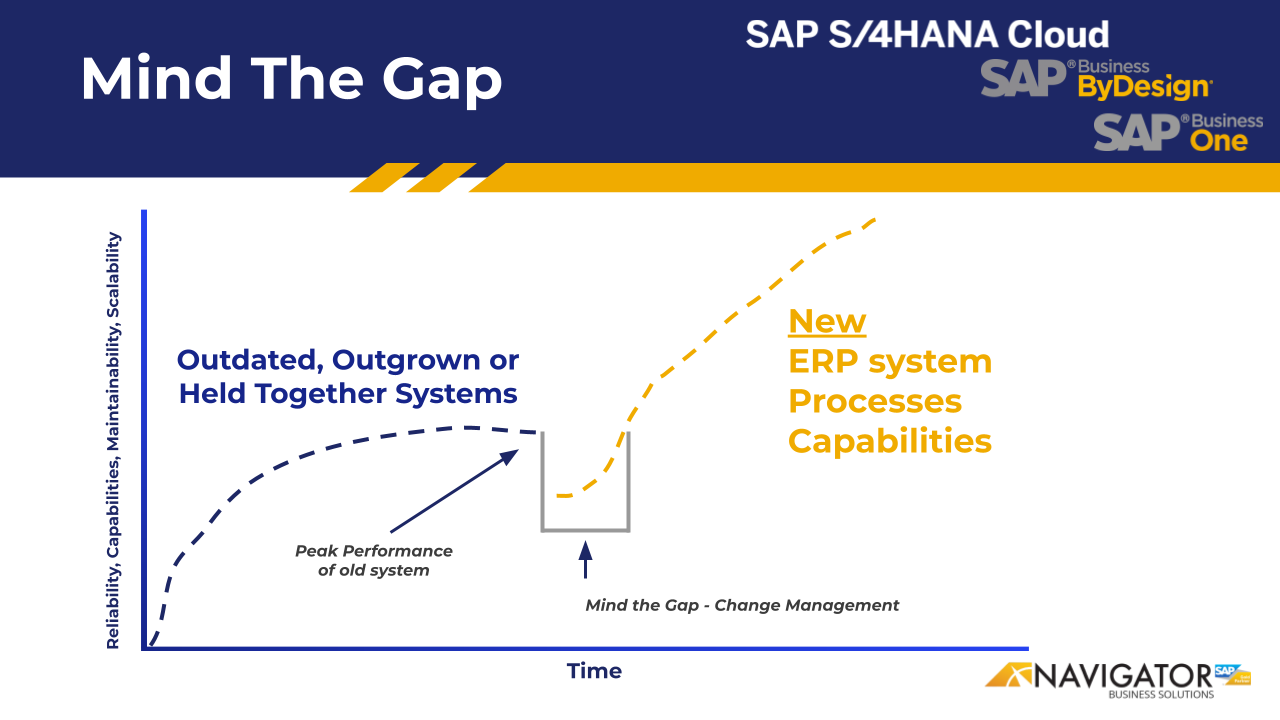
Your New ERP is Worse Than Your Old System—But Only for the First Year
There’s an interesting and well-known issue that many businesses face right after upgrading their ERP solution: The new system performs worse than the old one.
You know this because employees are complaining about the new solution, and you might be feeling it as well. Efficiency is down since the ERP rollout, more process errors are taking place, employees are confused, and simple tasks take longer now. The new system doesn’t feel easy to use, and nobody is happy after the big rollout that took so much time, effort and cost.
But relax. This is normal. Things will get better.
Intellectually, you know that the new ERP system is better than old one it replaced. You did your homework during ERP selection, and the new system both is more advanced and more capable than what came before. Your new ERP solves the business problems that existed with the old system, and objectively it is far superior.
At first, it won’t feel that way, however.
Why the New System Feels Like a Downgrade

For many businesses, the first 12-18 months with a new ERP system feel like a regression.
That’s because at first the new ERP system won’t work as well as the old system. There are two main reasons for this, both temporary.
First, there are kinks in the system. A new ERP encompasses all areas of a business, making ERP rollout a complex process. Inevitably, there will be some decisions during implementation that need adjustment after real-world conditions are known. These kinks might be process adjustments or configuration that didn’t quite meet actual needs. But these will get adjusted with time.
Second, there’s habit. Employees knew the old system, and now there is a new way of doing business. Any time a process or interface is changed, there will be pushback. This is normal and part of the human condition, so employees that knew the old system will inevitably favor it over the new. This is a temporary condition while they learn the new system. Of course the old system will feel better at first, and it might even objectively be better for a time while employees learn the new ERP solution. But employees will learn the new system.
How to Overcome the Temporary Disappointment and Despair
The initial disappointment and frustration with the new ERP system isn’t unique to your business. Even with good selection and competent implementation, the trough of disappointment right after rollout is common.
Because it is so common, there are some best practices for reducing this difficulty and more quickly moving past it.
These best practices are best implemented before system rollout, but they can be instructive and applicable even if your system already is live and employees are complaining.
1. Turn Off What You Don’t Need
ERP is complex, and it can do a lot for your business. This large feature set can make it confusing and overwhelming for new users.
Cut down on overwhelm by simplifying the system. Turn off modules and features that your business isn’t actually using. Less features means less confusion and complexity, and this will make adjustment to the new system easier. Reduce the clutter.
2. Consider a Phased Rollout
There probably are many areas where the new ERP solution will improve your business. Rolling out all these features and functions at once usually is a mistake, however. It increases implementation complexity and overwhelms employees and the business as a whole during rollout.
Instead of fully implementing your new ERP all at once, consider a phased rollout where functionality is added progressively over time. You might start with rollout to only one part of the business, for instance the finance or accounting functionality. Or you might stick to core functions at first and add additional processes and capabilities with time.
A roadmap that progressively adds features and functionality makes the transition to a new ERP system much more manageable and easier on employees.
3. Focus on Change Management
System configuration is only part of ERP implementation. Arguably the bigger project is change management, the process of onboarding employees and getting them comfortable with the new system and its processes.
When rolling out a new ERP solution, make sure adequate time and resources are devoted to this necessary change management function. Helping employees get up to speed is a major component of an ERP rollout, and this phase of the rollout should be stressed and built into the overall plan from the beginning.
4. Don’t Declare Victory After Rollout
The mission isn’t accomplished when your new ERP system goes live, because adjusting to the new system and its processes takes time. The false sense of project completion that comes from declaring victory upon go-live sets false expectations that the work is done and everything will now run smoothly. The problem is that it won’t run smoothly at first.
So instead of announcing that the ERP rollout is complete, position go-live as the ending of one phase and the beginning of the next phase where the system will be learned and adjusted. By shifting expectations for employees and management, early problems will be more easily understood as bumps in the road instead of actual solution failure.
5. Emphasize Early Wins
Some benefits of the new ERP solution will be immediately obvious, of course. Even while employees are learning the new system and kinks are being addressed, your new ERP solution likely will improve upon some problems that plagued the old system.
Focus on the parts of the new ERP solution that bring benefits from Day 1, and clearly communicate these wins company-wide.
Emphasis on what’s working will not lessen the frustration from the areas that are not performing well, but it will highlight that the new solution does bring advantages over what came before. When combined with acknowledgement that the system still is being refined (see tip #4 above), this will cut down on the sense that the new system is an actual step backward.
Need Help?
Planning and properly managing an ERP rollout can be tricky. This is one area where an experienced ERP implementation partner can make a huge difference.
We’ve seen this cycle of early disappointment and despair before. The good news is that it will get better—and there are ways to make the transition easier.
If you would like a helping hand with your ERP rollout, or advice on how to deal with this change management problem, contact one of our experienced ERP consultants by calling (801) 642-0123 or emailing info@nbs-us.com.